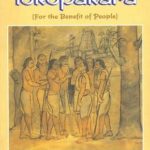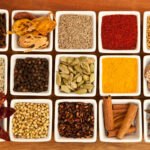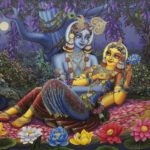Continuing Food Week here on the Indic Civilizational Portal is a work of Literature mentioned in our preceding Post on Classical Indic Cuisine.
The Paaka Darpana of King Nala of the Nishadas is the oldest available text on Indian Cookery. Although we already conducted a brief expository on it, it’s important to—pardon the pun—flesh out the details of this little known composition.
Any mention of Culinary Literature is incomplete without discussion of the Paaka Darpana. Meaning ‘Culinary Mirror’, it is an ancient work with modern applications. It helps us understand not only what unites Indian cooking—real Indian cooking—from Kashmir to Kanyakumari, but also gives insight into what many Ancient Bharatiyas actually ate.
Author
The legendary lord of the Nishaadas, Nala is a famed hero mentioned in the Mahabharata as the other half of that Pauranic Power Couple Nala & Damayanti.
It is said that he was extremely good looking, truthful, brave, just and endowed with eight boons. [1]
Nevertheless, as is famously recounted in the Naisadheeya or Naisadha Charita of Sriharsa , Nala (like another famous Mahabharata character) was not good at dice. He lost his kingdom in a wager with his brother Pushkara, and he too had to go into exile. It was in these circumstances that he became a chef in the Royal Kitchen of Rtuparna, King of Ayodhya. To preserve his real identity, Nala took the name Bahuka, and explained the Art of Cuisine to Rtuparna.
Interestingly enough, Nala later mentions his name in the Paaka Darpana and describes his travails. Damayanti is also discussed as is her later svayamvara.
King Nala himself is a member of the Nishada tribe. While the tale he is best known for is for another time, some of the slokas in this work give us insight into not only his surface-qualities, but also his substantive ones as well.
“The king (Rtuparna), addressing Nala, asked him many questions regard-ing the dietics and regimens to be observed in various seasons. He puts forth many epithets to Nala…O, supreme one amongst the expert cooks having parexcellence knowl-edge of the science of cookery, authority of science of cooking, all round expert of sorts, of cooking procedures, O observer of auster-ity, O, proficient O, personified lion among the elepha[nts]. O, Baahuka (Nala), kindly exhibit the procedure of consumable articles, beneficial to everybody, to be taken in various seasons.” [1, 79]
The traditional seasons per the Indic Science of Time-Keeping are “the seasons of spring (Vasanta), summer (greeshma), early rains (praavrt), rains (vaarshikaa), autumn (saarad) and winter (hemanta) are observed in fore-noon (purvaahna), midnoon (madhyaahna), afternoon (aparaahna), evening (pradosha), midnight (ardharaatra) and dawn (pratyushas) respectively.” [1, 79] It’s clear the great Nala of the Nishaadas has a solution for every season.
Whatever your tastes, however, it’s quite clear what he had in mind for good food was the Royal Rajbhog and all the intricacies of its preparation. However, the composition itself explicates the breadth of his knowledge more than any would-be biographer could do.
Composition
Credited to Nala of Nishada rajya, Paaka Darpana is a Sanskrit work. It contains 761 slokas and is divided into 11 chapters.
In this wo[]nderful book the author has described the recipes of vegetable & non-veg. preparations. Dishes prepared from Neem, Mandan, Guduchi, Jackfruit etc. become cures also besides being very tasty, the dishes are made fragrant before being served.[2,1]
A manuscript exists at the Saraswati Bhavan Library of Sampurnanand Sanskrit University at Varanasi.
- Chapter 1: By far the longest chapter (half the work), it introduces the topic and deals with the five key categories of food: pulses, rice, and meat.
- Chapter 2: Discusses the various seasons and the food regimens to be observed. The influence of Ayurveda is obvious here.
- Chapter 3: Treats the item of Bhaksyaraaja and various other dishes containing Egg
- Chapter 4: Focused on Phirni (kheer). Interestingly, different varieties of Paayasa are mentioned, as well as syrups such as Paanaka (Sri Rama‘s favourite).
- Chapter 5: Surveys the process pertaining to the preparation of different varieties of soft beverage, particularly their storage.
- Chapter 6: Presents the various processes and properties of different soups (yoosa)
- Chapter 7: Discusses the aspects of various Ghee preparations (Ghrtannapaaka) & Cereals.
- Chapter 8: Lehya (lickable) foods, such as the mango, are mentioned
- Chapter 9: Surveys the process of cooling water, giving fragrance, and preparing delicacies
- Chapter 10: Ksheera-paaka, or general cooking of mixed dish milk preparations
- Chapter 11: The last chapter overviews the processes of creating curd from milk
As a matter of interest, the original manuscript does not have these 11 paricchedas, and was found as one continuous composition (without punctuation).
Nala describes the various qualities of a cook (sooda ) and expert chef (soodaraat), which the reader can review among the selections. Nevertheless, the Nishaada king also describes the qualities of a proper waiter. Here is the gist below:
The waiter-at-meals (parivesaka) should attend to ablu-tions…followed by cleanliness of the feet and hands. He should be a fulfiller of culinary desires, attentitive to mind, firm/adherent, familiar with the timing of the meals of the king. Thereafter, he should serve the meals and food-prepara-tion in set order having come to know the appropriate time set for a king and considering its wholesomeness. [1,9]
The importance of cleanliness is quite apparent from the outset. Uniquely the cleanliness specified is not only a physical one, but a mental and even spiritual one. While the feasibility of ensuring such a level of saucha may indeed stretch credulity in our era, the emphasis on hygiene should, nonetheless, be feted and emulated. Whether chef or waiter or sommelier, one who furnishes food for others should take care to honour their trust. There is an implied guarantee of cleanliness.
In the same chapter, Nala also outlines the work in slokas 28-32, albeit in greater detail than the list at the top:
“The first section of the treatise deals with boiled rice (odana) with its various preparations; second one appraises the variet-ies of pulse (soopa); third one describes the clarified butter (sarpis); fourth one presents various varieties of recipes (vyanjana); fifth one depicts several preparations of meat (maamsa) and vegetables (shaaka); sixth one narrates a number of preparations of semi-hard food (bhakshya); seventh one introduces the preparations of Paayasa (rice cooked in milk with sugar added to it); eighth one elucidates an elixir (rasaayana); ninth one describes the preparation of syrup (paana) with its varieties; tenth one considers the varieties of soup (yoosa); eleventh one contemplates the food and its varieties processed by clarified but-ter; twelfth one exhibits the lickable (lehya) articles with its varieties; thirteenth one focuses the various beverages (paaneeya); thirteenth con-fines to several preparation of milk (ksheera); fifteenth one puts forth various preparation of curd (dadhi) and the last sixteenth one states the various preparations of butter-milk (takra).” [1,9]
Thus, one can see from this exegesis an inclusion of not only common staples such as rice, supplemented by vegetables, but also different types of meat.
Meat Recipes
Meat (maamsa) is reviewed with precision, particularly with regard to preparation and cleaning. Many different exotic meats are also discussed (it is not known if Nala’s tribal background influenced the selection). These range from curries to rice dishes. The most important however is referred to as simply maamsodana.
“Preparation process of Maamsodana (Pulaava)—The cook skilled in processing should fill up the 3/4 part of the cauldron (Sthaali) by the water hereafter it should be kept on fire place (stove or chulha). When water becomes heated the well-washed rice should be dropped in the quantity of one fourth of the [vessel]. When the Sali rice becomes semi-cooked, meat either, completely cooked or semi-cooked in the form of minute pieces alike rice should be mixed along with salt. This cooked rice should be fired with clarified ghee. After disappearance of watery residue, it should be put on the coalfire (Angar). Afterwards the coconut water and new ghee should also b[e] mixed and should be scented with the flower of screw pine (Ketaki). Hereafter the pieces of Parpata should be dropped and it should be made scented through the product of Camphor and Musk (Kastooree).” [1,22]
A rice dish known as chitrapaaka is discussed, and a full recipe given (sl.86). It is to be prepared in a special non-metal vessel known as Pugapada. It is mixed with salt, musk and ketaki flower, camphor, saffron and water. Lemon, mushroom, coriander, ringer and onion are also to be included. Option of adding meat after all this is prepared exists as well.
There are many, many other recipes including those for kukkutamaamsatailodana (chicken pulao with asafoetida, sl.100), sooksmaamsoddana (minced chicken pulao, sl.103), etc.
As such, many of the items he mentions are not only non-traditional to modern Hindus, but also notable for lacking any dishes with cow meat. Thus, even a tribal king with even fewer restrictions than so called “savarna” Kshatriyas, did not advocate beef. Therefore, we can see an integral unity in this myriad diversity.
The cow remains sacred for all Dharmic peoples.

Slokas 341-344 also discuss different spices. It appears the addition of ginger and garlic is nothing new to Indian cookery, as there is clear mention of it here. But shakaharis and sattvik chefs need not fear. There are also a number of vegetarian main courses mentioned as well.
Vegetarian Recipes
Preparation of pulses is discussed in great detail with the mixing of turmeric and asafoetida. Different types of pulses are also described such as horse-gram (kulattha), black-gram (masa), flat bean (nispava) in sl.121. Pulse itself is described as an alleviator of pitta and a promoter of health [1, 27]. Thus, we again see the background influence of Ayurveda here.
Shigruphalam (drum-stick), plantain (kadhalee), audambara (Indian fig), tiktaalaabu (bitter gourd), are all vegetarian options and their dishes all discussed as well. For sake of familiarity, a recipe for a brinjal (vrnthaakam) dish will be described here:
“Method of preparing the vegetable of Brinzal and its properties. The lovely young fruit of brinzal should be taken and its upper portion should be cut by a sharp-edged knife. After cutting the brinzal into two parts, it should be dropped into a pot filled with water. The round brinzal fruit should be cleansed by the water and it should be dipped into the water medicated with ginger. It should be mixed with asafoetida, Kaayaphala (Kaidarya) and coriander powder. It should be added by the pieces of garlic and ginger and it should be kept on fire. The round brinzal fruit cut into pieces should be kept in hot water for a while and it should be brought out of the water. After making the paste of spices containing black pepper coriander, cumin seeds (jeera) mixed with ripe tamarind and curd should be pasted on the pieces of brinzal fruit and it should be fried in cow’s ghee (clarified butter). After taking it out, it should be made fragrant with the camphor. Hereafter it should be kept in clean pipe of puga-putta boiling ghee. After taking out it should be eaten.” [1, 38] It is praised as “an alleviator of Tridosha” and an enhancer of strength. [1, 38]
But the best of all vegetarian dishes is described as Bhakshyaraaja, King of the Edibles:
“The cook should take on part of the pieces of raw wheat along with the one part of fragrant article in order to cook it properly. The well cooked pulse of Bengal gram (canaka) taken as half part and one part of fat and one part of the flat bean (Nispaava) along with the five pieces of co[co]nut, fruit mixed with cardamom (elaa) and salt in appropriate quantity. All the above substances should be cooked properly and the butter ex-tracted from the scented milk should be mixed in boiled milk. after mixing all these, the pills should be prepared like seeds of lemon and these should be kept in pugapatta. These pills, after some time should be again cooked and dropped in the ghee. This preparation is called Bhakshyaraaja.” “It is celebrated as an alleviator of vaata and pitta, promoter of digestive power, palatable, and a strength promoter.” [1, 86]
In terms of vegetarian items of regional interest, Odias would be interested to hear about the preparation of the Kalinga fruit (sl. 444). Kashmiris might relish the description of Lotus flower, Padma-patra-shaaka (sl.477), as a dish.
Rasa & Ayurveda
The editor’s note gives a detailed discussion of rasabhinivritti (Manifestation of taste) and expounds on how “Location (desa) plays a great role in manifestation of various tastes in one substance, e.g.grapes and pomegranates growing in the Himaalayas are sweet in taste whereas those growing elsewhere are sour“. [1, 11] Taste which manifests immediately is referred to as rasa, while that which manifests later and slightly is called anurasa. Nala himself specifically mentions 8 demerits in food, along with various characteristics of starch.
Medicinal aspects are also discussed, such as how to alleviate pain from a scorpion-sting. This circles back to the overall connection to Ayurveda. Although naturally Nala being not just an ordinary cook, but a royal chef is expected to be mindful of taste, the centrality of nutrition and health is apparent. Incidentally, seasonal regimes (for purposes of health) are avidly described in chapter 2. Special care is taken to assert the need for more caution during the changing of seasons.
Nala himself recommends certain meats in certain seasons, suggesting deer in spring, goat in summer, chicken in rainy season, fish in autumn, pork in winter, and sparrow in late winter (sl.31).
Of course, no discussion of the composition would be complete without mention of the desserts. While foreign attribution of all things Indian may be popular (even phirni!), here is King Nala’s recipe for Kheer, better known as Ksheerapaaka.
“Milk, unmixed with water, should be kept in a milk vessel. it should be cooked in slow heat in cauldron and stirred with ladle…Milk which has become drinkable is to be added by the jack-fruit. in the milk, which has become more solidified, the ginger should be added by another fruit. Later on the flowers of Punnaga should also be added to it. the milk known as ghatika is to be added by the mango fruit along with ghee and honey. In this way, the flower of pomegranate and rice should be added, when the milk becomes in ‘Sarkara’ form, banana fruit is to be added along with sugar.” [1,109] It is described as glorified by the Gods and alleviates the disorders of Tridosha.
Selections
Ekaaki naishadhah kadaachit kalinaashanah |
Rtuparnasya nagaree raajaanamidhamabraveet || sl.1
Long ago, having reached the city (Ayodhyaa) of Rtuparna, Naisadha (king of Nisadha county as Nala) the persecutor of Kali (the demon who rules in Kali Yuga) alone spoke thus to the king. [1,1]
§
(Panchavidha bhojanasya bhedhaah) Bhakshyam bhojyam tatha lehyanchoshyam peyam payogatham |
Bhedham rasaanaam shannaancha shuddha-samskaara-bhedhathah | sl.4
(I know the food-stuff classified into five categories viz., bhakshya [semihard food like sweet-ball (laddu) etc.] bhojya (soft food like rice, pulse etc.), lehya (relishable or lickable articles like sauce), cosva (suckable articles like sugarcane, pomegranate etc.) and peya (drinkables or beverages like fruit-juice, wines etc.) possessing either the six tastes (sweet, sour, salt, bitter, pungent and astringent) on the basis of preparation and processing. [1,2]
§
“Bhujyathe yena yatnena tasyaarogyam bhaved bhruvam |
vaatajam pittajam rogam sleshmajam hanthi sarvadaa ||
Sakrunnishevanenaiva tripuram tryambako yathaa || sl.6
Person, who relishes the aforesaid dishes (citrapaaka) with care and prepared by me, gets positive sound health. If this preparation is taken even once, alleviates the diseases caused by Vaata, Pitta and Sleshman as Lord Siva (Tryambaka) had killed the demon Tripura.” [1,3]
§
Asminnaarthe mayo’kaari grantho leka hithaaya cha|
loka paala-prasaadena paakadarpanaaamathah||
Tasyaava-lokanenaiva drsyanthe vividhaah kriyaah |
Soodasya lakshanam thaavad vakshye samkshepatha prabho || sl.22
O lord (prabhu) king Rtuparna. I have composed a trea-tise entitled Paakadarpana in this regard by the grace of gods (lokapaalas) for the benefit of people. All the process of (cooking) would be conspicuous by going through it. Now, I shall narrate the characteristics of cook (sooda) succinctly).
§
Svadesamsabhavah prajnha sarva-lakshana-laksithah |
Sadaachaara-samaayuktho visishta-kulasambhavah ||
Shaantho daantho daanasheelo raajapoojyo shuchismathah|
svadaaraniratha shuddhah paradaaravivarjithah ||
Bhitha-bhaashee sadaa daathaa dayaaluscha subhasitah |
Dhaathujno desakaalajno vayo’vasthaadhividh budhah||
The cook (soodha) appointed in a particular place, must belong to that habitat. He should be intellectual, endowed with all the required merits and characteristics, possessing the moral and ethical values, hailing from a respectable family, qu[iet], subdued, generous, honored by the royal families, pious, smiling, devoted to his wife, averted from other’s wife, holy, speaking measured words, liberal, com-passionate, soft spoken, familiar with various metalic utensils, conversant with place and seasons and detector of age and phases of life and also wise. [1,8]
§
Sarveshaam praaninaam praanam-annam prathama-muchyathe |
Brahma-roopamidham samyak-trishashti-rasa-roopakam ||
Doshashtakena rahithamaahared-annam-uttamam || sl.37
Food is primarily said as sustainer of vital force (Praana) of all living beings. Food, containing the sixtythree types (on the basis of combinations and permutations) of rasa (tastes) is factually personi-fied as Brahma (creator of the universe). The best food is that which is devoid of eight types of impurities. [1, 10]
§
Soodha-vedamakhilam susooksmayaa savidaa samavalokya sarvathah|
paaka-roopam-abhidheya-maa-daraadhyo bibarthim hrdhayena soodhaaraat || sl.498
Attainment of the post of expert cook. The best cook is one, who, having gone through cookery very attentively and pre-cisely from all the aspects; possesses the knowledge of all sorts of cooking by heart. He is also known as the king of the cooks. [1,78]
§
Click here to Buy this Book Today!!!
References:
- Madhulika, Dr. & Ed. Jayaram Yadav. Paka Darpana. Varanasi: Chaukhambha Orientalia. 2013







